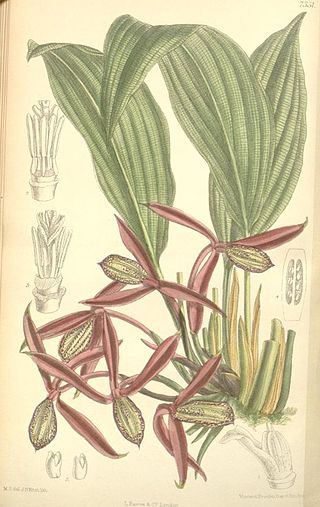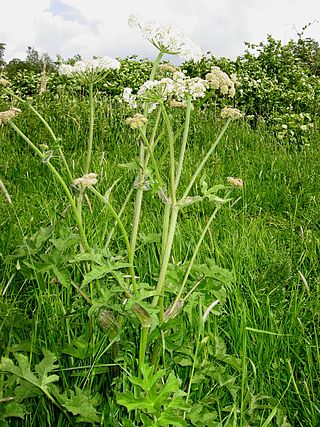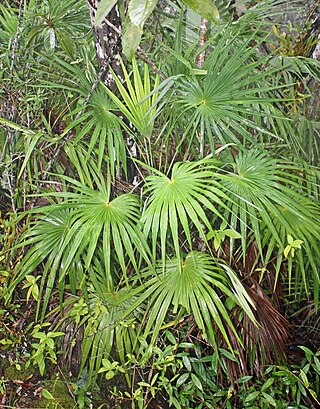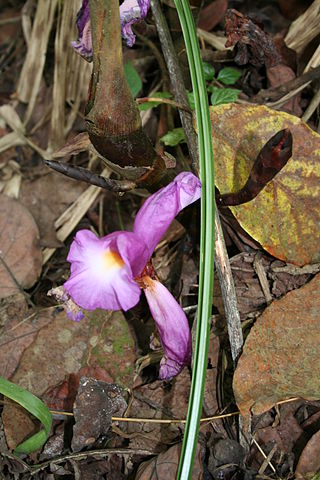
Zingiberaceae or the ginger family is a family of flowering plants made up of about 50 genera with a total of about 1600 known species of aromatic perennial herbs with creeping horizontal or tuberous rhizomes distributed throughout tropical Africa, Asia, and the Americas. Many of the family's species are important ornamental, spice, or medicinal plants. Ornamental genera include the shell gingers (Alpinia), Siam or summer tulip, Globba, ginger lily (Hedychium), Kaempferia, torch-ginger Etlingera elatior, Renealmia, and ginger (Zingiber). Spices include ginger (Zingiber), galangal or Thai ginger, melegueta pepper, myoga, korarima, turmeric (Curcuma), and cardamom.

Zingiber is a genus of flowering plants in the family Zingiberaceae. It is native to Southeast Asia, especially in Thailand, China, the Indian Subcontinent, and New Guinea. It contains the true gingers, plants grown the world over for their culinary value. The most well known species are Z. officinale and Z. mioga, two garden gingers.

Orchidantha is a genus of flowering plants. In the APG III system, it is placed in the family Lowiaceae, as the sole genus. It includes the plants in the formerly recognised genera Lowia and Protamomum.

Henry Nicholas Ridley CMG (1911), MA (Oxon), FRS, FLS, F.R.H.S. was an English botanist, geologist and naturalist who lived much of his life in Singapore. He was instrumental in promoting rubber trees in the Malay Peninsula that led to a level of rapid deforestation, instrumental in the 1926 Great Flood. For the fervour with which he pursued this work he came to be known as "Mad Ridley".

Amomum is a genus of plants containing about 111 species native to China, the Indian subcontinent, Southeast Asia, New Guinea, and Queensland. It includes several species of cardamom. Plants of this genus are remarkable for their pungency and aromatic properties.

Heracleum sphondylium, commonly known as hogweed or common hogweed, is a herbaceous perennial plant in the carrot family Apiaceae, which includes fennel, cow parsley, ground elder and giant hogweed. It is native to most of Europe, western Asia and northern Africa, but is introduced in North America and elsewhere. Other common names include cow parsnip or eltrot. The flowers provide a great deal of nectar for pollinators.

Hopea is a genus of plants in the family Dipterocarpaceae. It contains some 113 species, distributed from Sri Lanka and southern India to the Andaman Islands, Myanmar, southern China, and southward throughout Malesia to New Guinea. They are mainly main and subcanopy trees of lowland rainforest, but some species can become also emergent trees, such as Hopea nutans.

Kerriodoxa elegans, the white backed palm, is the only species of palm tree in the genus Kerriodoxa, in the family Arecaceae.

Maxburretia is a genus of three rare species of palms found in southern Thailand and Peninsular Malaysia. The genus is named in honor of Max Burret, (1883–1964) a German botanist.

Aframomum is a genus of flowering plants in the ginger family, Zingiberaceae. It is widespread across tropical Africa as well as on some islands of the Indian Ocean. It is represented by approximately 50 species. Its species are perennials and produce colorful flowers. Several aromatic species with essential oils present in fruits, seeds, leaves, stems, rhizomes, and other plant parts are either edible or used as medicine in Africa.

Wurfbainia villosa, also known by its basionym Amomum villosum, is a plant in the ginger family which is grown as a cardamom-like spice throughout Southeast Asia and South China. Like cardamom, the plant is cultivated for its fruits, dry capsules containing strongly aromatic seeds. W. villosa is an evergreen monocotyledonous plant 1.5 to 3.0 m in height, the branches and leaves of which are similar to those of ginger. It grows in the shade of trees and has a reproductive peculiarity whereby those flowers borne on creeping growth at ground level will set fruit, while those borne on aerial branches will not. It blooms in March and April, the colour, translucency and waxy lustre of the flowers being likened traditionally to those of white jade.

Magnolia liliifera, commonly known as egg magnolia, is a flowering tree native to the Indomalayan realm. It bears white to cream-colored flowers on terminal stems. The leaves are elliptical and get as large as 25 cm (10 in) long and 8 cm (3 in) wide. The tree ranges in height from 3.5 to 18.5 m in situ.

Wurfbainia is an Asian genus of flowering plants in the family Zingiberaceae. Species in this genus have been recorded from the Himalayas, South China, Indo-China and Western & Central Malesia. It has previously been placed as a synonym of Amomum.
Conamomum is a genus of flowering plants in the family Zingiberaceae and tribe Alpinieae. Its native range is from Indochina to western Malesia.
Adelmeria is a genus of perennial herbs in the family Zingiberaceae which are endemic to the Philippines. Previously, Adelmeria had been considered a synonym of the genus Alpinia, however, after a study showed Alpina to be highly polyphyletic, it was determined in 2019 that Adelmeria was a distinct genus.
Wurfbainia vera is a herbaceous plant in the Zingiberaceae family. Formerly called Amomum verum, it was the first plant species to be named by a woman, the Scots artist Elizabeth Blackwell in 1757. The Kingdom of Siam obtained the fruit (seeds) of the plant from Cambodia in the 18th century to export as a spice to China and Europe. The species occurs not only in Cambodia, but also in Sumatra, Thailand and Vietnam. The young leaf, the fruit and the seeds are edible, the seeds are known as Siam cardamom in English.
Memecylon cantleyi is a shrub or tree species in the Melastomataceae family. The flowers are white and vivid blue. The plant is native to an area from Borneo to Sumatra to Thailand. A name given to the tree in Malaysia, nipis kulit, translates as "calamondin bark".
Epiamomum is a genus of plants in the family Zingiberaceae and tribe Alpinieae; all records to date are from Borneo island. Before 2018, some species were placed in the genus Amomum.
Newmania is a genus of rhizomatous based flowering plants belonging to the family Zingiberaceae. They are only native to Vietnam, and found in forests.











